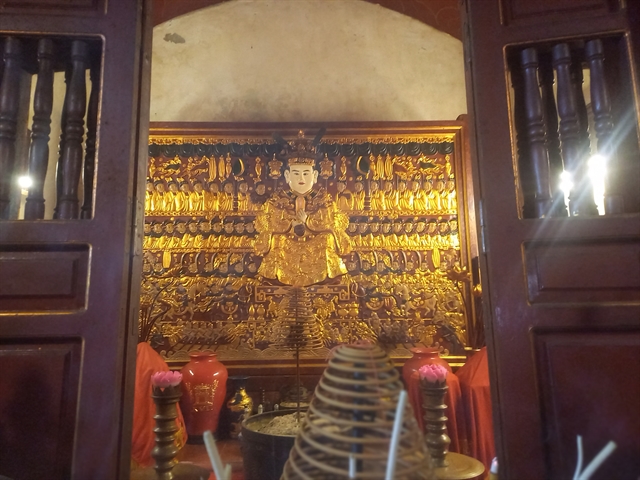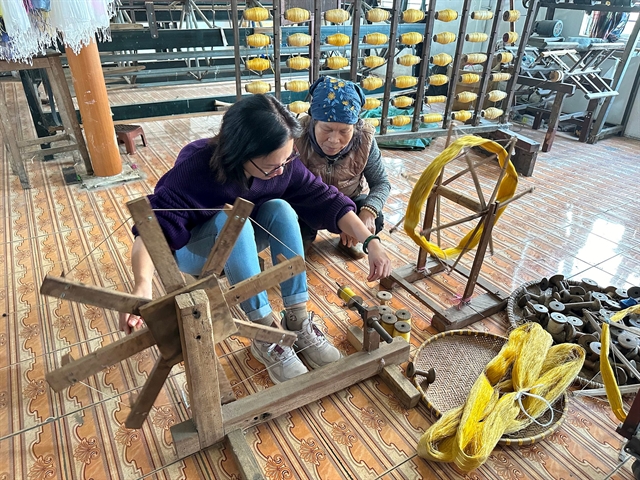 Sunday/Weekend
Sunday/Weekend

 |
| SEEING RED: Visitors check in at the Quảng Phú Cầu incense-making village. VNS Photo of Mai Trung Kiên |
Thanh Hà
Traditional craft villages and cultural heritage will be the highlights of Hà Nội's tourism in 2024 as the local authorities have planned new tour routes to lead visitors to the city's undiscovered suburbs.
Joining the "Exploring the heritage road in South Thăng Long" tour, people will travel from the city centre to the outlying districts of Thanh Oai, Ứng Hòa and Mỹ Đức.
The first destination is the Nội Bình Đà Temple-Communal House in Thanh Oai, which is about 20km from Hà Nội centre.
Visitors will learn about the architecture, cultural and historical values of the temple worshipping the nation's legendary founder Lạc Long Quân.
They will listen to the myth of Dragon King Lạc Long Quân and Mountain Goddess Âu Cơ. After their marriage, Âu Cơ gave birth to a sac containing 100 eggs from which 100 children were born; this is the origin of the Vietnamese people.
The story is told in different places in the country, but only at the Nội Bình Đà Temple can visitors admire the famed bas-relief of Lạc Long Quân, which was recognised as a national treasure in 2015.
The bas-relief depicts the nation founder seated on a throne, wearing a crown and an imperial cloak, while watching a boat race with characters from the Hùng Kings era.
"Actually, no one knows exactly when the bas-relief was made. We could only tell that it was made a long time ago. It is more than 600 years old," temple custodian Nguyễn Chính Chinh told Việt Nam News.
 |
| ICONIC: The precious bas-relief depicting national founder Lạc Long Quân at the Nội Bình Đà Temple-Communal House in Thanh Oai District. — VNS Photo Thanh Hà |
"The precious treasure is a gilded rare wood carving. Many archaeologists have proposed to rank our temple-communal house as a special national historical site, to express gratitude and honour to nation father Lạc Long Quân," he said.
Earlier in 2014, the National Founder Lạc Long Quân Temple Festival, which is held annually from the fourth to the sixth days of the third lunar month, was listed as a national intangible cultural heritage.
"I am interested in visiting the Nội Bình Đà and surprised to see the bas-relief for the first time. It not only tells history but is also a beautiful art work," said Mai Quyết Thắng, a Hanoian visitor.
His wife Trần Diệu Thủy meanwhile enjoyed shopping at the local wet market, where she bought green and clean vegetables, fruits and traditional cakes.
"These products are brought from the farmers' garden to the market. They are not only cheaper than in the city but also fresher," said Thủy.
From Nội Bình Đà, visitors travel 20km to reach Quảng Phú Cầu Village in neighbouring Ứng Hòa.
The village is well known for its century-old craft of making incense sticks and is now a most eye-catching craft destination with exuberance and selfies galore.
 |
| TOUCH OF COLOUR: A visitor poses for a photo with bunches of colourful bamboo sticks in Quảng Phú Cầu Village. — VNS Photo Hoàng Quyên |
All pavements and roads in the village are coloured with the pink and red of incense sticks, while its gentle scent makes people feel relaxed when walking around. Bundles of incense look like giant flowers, which are shaped into beautiful mini-scenes.
"Usually, we produce the incense sticks in pink and red. The other colours are for tourism purposes only," said villager Đỗ Thị Tâm.
Tâm and other artisans in Quảng Phú Cầu are happy to show tourists the technique of making incense sticks traditionally. It was no problem if anyone wanted to try the producing process from splitting the bamboo tube into thin sticks to dying, shaping and drying them, she said.
In the yard, visitors feel free to snap photographs. Here, they can enjoy local cuisine such as bánh đúc (plain rice flan), bánh khúc (cudweed sticky rice cake) and fish rice soup.
"We welcomed visitors from different countries such as India, France and South Korea every day. They come to learn about our ancient craft and the village's story and culture," said Nguyễn Đức Bình, head of Ứng Hòa District's Culture and Information Department.
"We will upgrade the infrastructure, environment, landscape, and our speciality products to draw in more tourists to our village."
 |
| FRUIT OF THE LOOM: Artisan Phan Thị Thuận (left) talks with her visitors about Phùng Xá silk and her lotus silk. — VNS Photo Hoàng Quyên |
Leaving Quảng Phú Cầu, it is only 10km to Phùng Xá Village with its renowned silk craft in Mỹ Đức District.
Here, visitors can experience picking mulberry leaves to feed silkworms, spinning yarn and especially making lotus silk with master artisan Phan Thị Thuận.
The 70-year-old woman has worked with silk most of her life, aiding the revival of the traditional craft village.
Thuận is the only artisan in Việt Nam who weaves silk cloth from lotus fibres and uses silkworms to weave blankets.
 |
| SILKY SMOOTH: A visitor tries to practise silk spinning with an artisan at Phan Thị Thuận's workshop. VNS Photo Hoàng Quyên |
"My daughter studies fashion. She searched and discovered the village online, so we decided to visit Việt Nam," said visitor Michelle Trần who lives in the US.
"We are happy to see how Thuận and other artisans make ordinary silk cloth and lotus silk. We buy some of her beautiful products which are different to what we have had before. I think it would be good for my daughter to use these materials for her studies."
Phan Huy Cường, of the Hà Nội's Department of Tourism, said that the new routes would help connect localities and itineraries and bring new products and experiences to tourists in 2024. VNS




